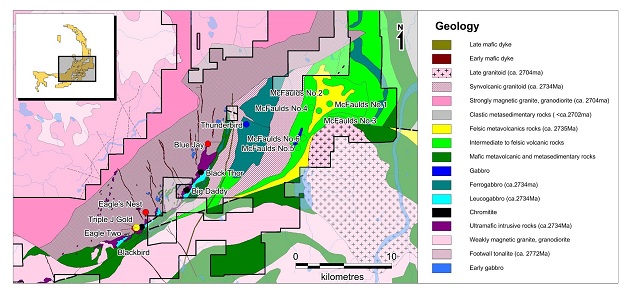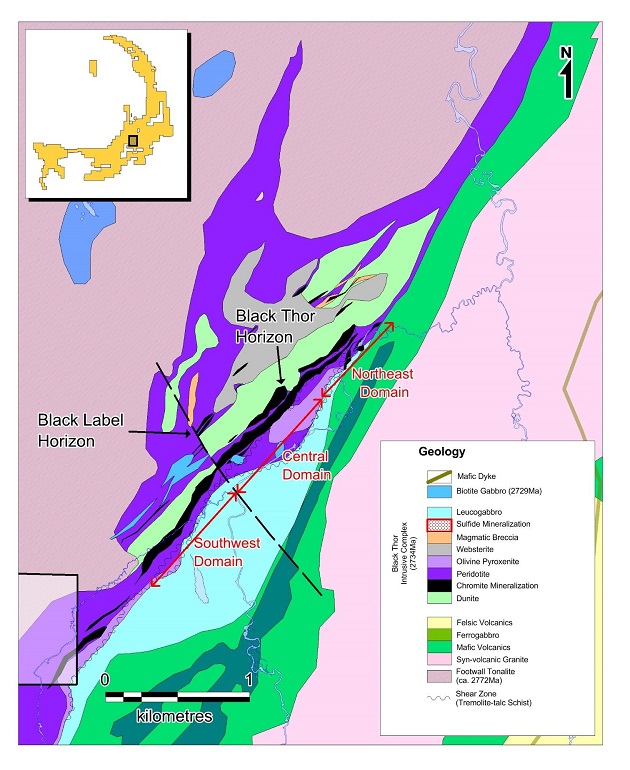Noront Resources Ltd.
Black Thor & Black Label Chromite Deposits

Overview
The Black Thor chromite deposit was discovered in 2008 by Freewest Resources while testing a 3 km gravity anomaly. Further drilling in 2009 revealed another parallel chromite horizon 150 m to the northwest now known as Black Label. It is the largest chromite deposit in the ROF and was the subject of a feasibility study by Cliffs Natural Resources, whose goal was to develop a large scale chromite mine, integrated transportation system and ferrochrome processing facility in Sudbury ON. Cliffs sold the Black Thor project, along with the rest of its assets in the ROF, to Noront in 2015. Development plans for the Black Thor deposit will be determined after commissioning of the Blackbird chromite mine and construction of a supporting ferrochrome production facility in Sault Ste. Marie.
Deposit Geology & Mineralization
Regionally the Black Thor & Black Label deposits are associated with an ultramafic sill complex situated at the contact between a large tonalite body to the northwest, and an overlying volcanic sequence to the southeast (figure 1). At over 16km in strike length and up to 1.5km in thickness, this sill complex is believed to consist of at least two individual sills known as the Double Eagle Intrusive Complex and the Black Thor Intrusive Complex. Both contain an ultramafic keel and/or feeder dyke with attendant Ni-Cu-PGE mineralization, overlain by a crudely layered ultramafic sill with thick accumulations of chromitite.

FIGURE 1- REGIONAL GEOLOGY OF THE SOUTHERN ROF

FIGURE 2- BLACK THOR GEOLOGY MAP
The Black Thor Intrusive Complex is an overturned layered ultramafic sill-like body (figure 2) which hosts the Black Thor, Black Label and Big Daddy chromite deposits as well as the Blue Jay (AT12) and Contact Zone Ni-Cu-PGE occurrences. Coarse layering in the host ultramafic sill progresses from basal peridotite units upward into chromite mineralized dunite and peridotite into pyroxenite and finally a capping gabbroic unit. Ultramafic protoliths have all undergone varying degrees of serpentinization and talc-chlorite alteration. The chromite deposits in the ROF are globally quite rare and geologically similar to the Kemi chromite mine in northern Finland, currently operated by Outokumpu.
The Black Thor deposit represents >95% of the combined chromite resources of Black Thor and Black Label and is the largest chromite deposit in the ROF. Chromite mineralization is present as sub-vertically dipping thick (40-80m) intervals of fine-grained, heavily disseminated to semi-massive to massive chromitite layers continuous along strike for 2.3km. The Black Thor horizon can be sub-divided into three main domains: Southwest, Central and Northeast. The Southwest and Northeast Domains consist of two prominent chromitite layers separated by weakly mineralized dunite while the Central domain consists of multiple thinner chromitite layers within dunite. Faulting within the Northeast domain has resulted in structural repetition of the chromitite lens there. Black Label, located stratigraphically below Black Thor, is a series of discontinuous thin chromitite horizons which have been intruded by a late pyroxenite body interpreted to represent the final stage of ultramafic magmatism within the sill.

FIGURE 3- 3D GEOLOGICAL MODEL OF BLACK THOR (DARK GREY) AND BLACK LABEL (LIGHT GREY) CHROMITE DEPOSITS. OBLIQUE VIEW LOOKING NORTH.
Project Details
A detailed feasibility level analysis was completed on the Black Thor project by Cliffs Natural Resources in May 2013. The study contemplated an open pit mine with an 8:1 stripping ratio producing a diluted grade of 30.7% Cr2O3 ore over a 30-year mine life. Ore was then to be transported by truck and rail to a yet-to-be-built ferrochrome processing facility. The estimated capital cost was $4.4 billion over a 6 year construction period.
Project Status
Noront is currently reviewing the Feasibility Study for this site, along with the associated technical and social documentation. Our goal is to produce a strategic plan and a comprehensive preliminary economic analysis (PEA) for all the development options for the Ring of Fire chromite projects.
Current resources for Black Thor and Black Label are presented in the Table below.


Cut off is 20% Cr2O3. Please see report titled “National Instrument 43-101 Technical Report: Black Thor, Black Label and Big Daddy chromite deposits: McFaulds Lake Area, Ontario, Canada, Porcupine Mining Division, NTS 43D16, Mineral Resource Estimation & Technical Report” by Alan Aubut of the Sibley Basin Group, released July 27, 2015. CIM Definition Standards were followed for classification of Mineral Resources. The Mineral Resource estimate uses drill hole data available as of April 30, 2013 for the Black Thor and Black Label deposits and June 3, 2012 for the Big Daddy deposit. The cut-off of 20% Cr2O3 is the same cut-off used for the Kemi deposit as reported by Alapieti et al. (1989). Section 14.2 of the Technical Report includes a description of the key assumptions, parameters, and methods used to estimate the mineral resources. A copy of the Technical Report may be accessed under Noront’s company profile on SEDAR at www.sedar.com. Mineral resources that are not mineral reserves do not have demonstrated economic viability. The estimate of mineral resources may be materially affected by environmental, permitting, legal, title, socio-political, marketing or other relevant issues.
Source: https://norontresources.com/projects/black-thor-black-label-deposits/
